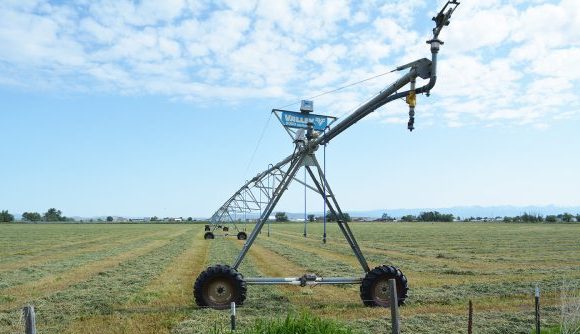Beef-on-dairy: Crossbred cows create additional revenue stream
Published 8:00 am Tuesday, September 19, 2023
TWIN FALLS, Idaho — While milk production remains the bread and butter at Bokma Dairy, selling beef-on-dairy crossbred calves for the feeder cattle market provides an important additional revenue stream.
Typically, 1,800 to 1,900 calves are born on the dairy every year. About 50% are beef crosses to be sold to a calf ranch in New Mexico.
“Right now, we’re getting $480 a calf — heifer or bull,” said Tyler Hyink, who with his wife, Johanna, is part owner of the dairy.
That helps when milk prices are as low as they’ve been this year — $6 to $7 per hundredweight below cost of production on the dairy.
The practice is becoming widespread in the dairy industry.
“It’s a positive, as is the cull cow price,” he said.
Cull cows headed for the hamburger plant are bringing $1,500 a head — a sign of the tight cattle supply, compliments of a persistent drought in some parts of the United States that scorched pastures and wilted feed crops.
Hopefully, those cull cow prices will spur a reduction in the national dairy herd and help bring milk markets back into balance, he said.
Right now, pure Holstein calf prices are $250 to $300 a head, but they can sink as low as $5 a head. Jersey calves have no value in the current market, he said.
New revenue
The dairy started breeding beef-on-dairy seven or eight years ago when prices for Holstein and Jersey calves were in the dumps.
“We decided it was an opportunity for new revenue,” he said.
The dairy works closely with its artificial insemination company to predict the number of dairy heifers it will need to maintain the herd. The operation uses dairy sexed semen on its heifers and cows with the best genetics to produce those needed heifers.
Beef semen is used on other heifers and cows to produce the crosses that will end up in a feedlot for beef production. The calf ranch in New Mexico provides the beef semen at no cost.
“That’s part of the deal. We’re under a contract to sell them the calf,” he said.
Day-old crossbred calves are sold to the calf ranch in New Mexico. Day-old dairy calves head to a local calf ranch that will grow them to 350-400 pounds before they return to the dairy.
Dairy producers have been breeding beef-on-dairy at some level for more than a decade, but it’s a growing trend, said Jamie Jonker, chief science officer for the National Milk Producers Federation.
Overall, 1 out of every 3 or 4 dairy calves born will be a dairy-beef cross, he said.
“So that’s substantial,” he said.
CattleFax estimates 2.6 million dairy calves born this year will be beef crosses. The estimate in 2016 was about 200,000, he said.
“That’s a pretty large change in a very short time,” he said.
Value prospect
The decrease in the national beef herd is making beef-on-dairy crosses more valuable. Those crosses bring three to four times the price of a dairy bull calf, and there’s still growth opportunities for beef-on-dairy crosses within the sector.
“I think their value has more recently increased because of the decrease in the national beef herd,” he said.
The beef cow herd is the smallest since 1962, and the inventory of all beef and dairy cattle and calves is the lowest since 2014, according to USDA’s July 1 inventory report.
“I think it’s really the value prospect” that’s driving the trend in beef-on-dairy, he said.
For farmers looking to maximize revenue in different parts of their farm enterprise, the sale of crossbred beef-on-dairy calves is important to consider, Jonker said.
“It’s a revenue stream in addition to milk, he said.”
Win-win proposition
The number of dairy-beef crosses in feedlots for beef production is about the same as pure dairy animals in feedlots, said Michaela Clowser, director of producer education for National Cattlemen’s Beef Association.
“We’ve seen quite a surge in the beef-on-dairy cattle. It’s been a big trend, and I think it’s here for the long haul,” she said.
It adds a lot of value for the dairy producer, and it meets a lot of the needs within the beef industry. There’s going to be more and more of those crossbreds, she said.
About 3 million beef-on-dairy cattle are currently in feedlots or on calf ranches. But that’s a conservative estimate; there are probably a lot more, she said.
Compared with pure dairy cattle, beef-on-dairy crosses provide higher quality beef products, a more uniform product, higher dressing percentage, fewer days on feed, a larger ribeye area and better muscle-to-bone ratio, Clowser said.
There’s also an opportunity to grade in a labeled beef program, such as Certified Angus Beef, and capture more value, she said.
The association has consistently heard feedlots will pay three to four times more for those crossbreds compared to pure dairy animals, especially when a marketing relationship is based on integrated supply where the feedlot retains ownership all the way through the supply chain, she said.
Feedlot owners say the crossbreds perform just as well as beef animals in the feedlot, they are feed-efficient and take fewer days on feed, she said.
Challenges remain
Packers pay the same price for the crossbreds as pure beef cattle, but there can be some challenges. Crossbred fed heifers are more apt to lactate than fed beef heifers. If they lactate in the processing plant, that spilled milk is a contaminant. It can’t be washed off, so it has to be cut out, she said.
Liver abscesses are another challenge for processors with beef-on-dairy, she said.
“An abscess could be so severe, processors have to cut into the skirt steak, and that could be a loss,” she said.
One study by Ty Lawrence, an animal science professor at Texas A&M University and director of the Beef Carcass Research Center, found liver abscesses in 68% of beef-on-dairy cattle.
Those abscesses are probably from diet, with dairy-beef crosses on grain-based calf rations high in protein. Traditional beef animals can graze, she said.
On the positive side, the frame size is usually smaller than that of pure dairy cattle and muscle shape and overall cutability are better, she said.
Owners: Willie and Valerie Bokma, Tyler and Johanna Hyink
Milking cows: 1,950
Breed: 80% Holsteins, 20% Jerseys
Average milk production: 80 pounds a day
Milking schedule: Cows twice a day, fresh cows four times a day for first 35-40 days
Farm: 1,400 acres of feed crops
Employees: 21










